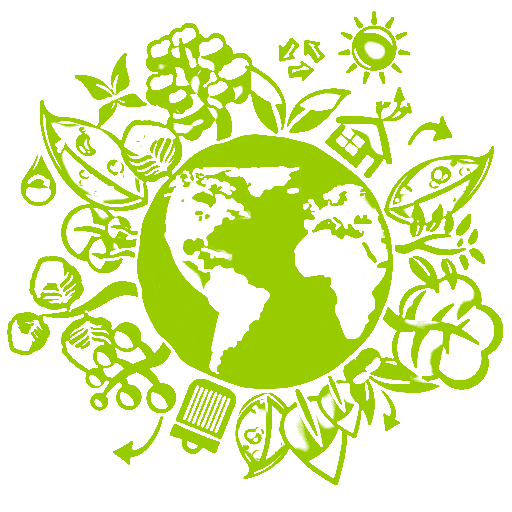-
Let’s Try A New Way
RECOVERING EDEN means different things to different people but for us, the primary goal was to strive for sustainability, simplicity and independence from corporate manipulation. We have no illusions about the fact that it can be a challenging path to follow but it has always been a dream of ours. We’ve left it late in our lives to try this but individually, our lives had some other lessons for us to learn first. Also, we now have a chance to prove that age doesn’t have to be a barrier to sustainable living.
I’m Terry, a 66 year cartoonist and photographer from Australia. Mel is 60, an artist and teacher from Wiltshire. We both knew we wanted something different from the life of desperate conformity and relentless capital growth that has brought our existence on this planet to such a precipice. But we ploughed very different furrows until, finally, we were presented with the signs that can no longer be ignored… divorce, disenchantment, burn-out, health issues… a healthy dose of life-sabotage to promote a hand-brake turn onto a new path. Happily, our respective paths converged and our respective slices of idealism found new resonance. We actually believed we COULD FIND A NEW WAY together.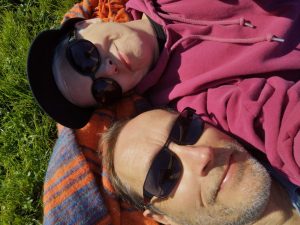
Getting Down to Earth Pretty quickly, some practical hurdles became apparent. We weren’t too flush for cash; we weren’t that young or able bodied (plenty of middle-age aches as well as a hip and knee replacement to be getting on with); we had pets that would almost certainly never co-exist in harmony (a young Saluki hound with formidable credentials as a ‘sight-dog’ and a grumpy, late-middle aged cat who has little regard for anyone or anything). Then there was the question of finding a plot of land and financing an eco self-build.
We want to create a healthy, sustainable and low-impact lifestyle for ourselves but also to inspire, involve and educate others. This blog is intended as the first step in that direction. In early 2020, we embarked on the purchase of a 3 acre plot with outline planning consent in Ceredigion, Wales. Then came COVID-19 and a period of limbo from which we are now hopefully emerging.Check out our next post for details on our land and the initial challenges we face. Meanwhile, here’s a bit more about our ethos.
THE BIG THINGS STAY THE SAME UNLESS WE MAKE LITTLE CHANGES. That is our call to action and our mission is to provide resources and opportunities to interact and learn pleasurable and rewarding alternatives that can help us live more sustainably. Individually, we may not change the world but if we become the change we want to see, then collectively we can be an instrument for global change. Your idea of ‘little’ may differ from ours but we accept the different starting points and mental preparedness we each bring to this challenge. Lao Tsu said it best with, the journey of a thousand miles starts with a single step.
Our intention is to create a sustainable and largely self-sufficient living space with on-site resources to offer teachings in a range of subjects including:
– Mindfulness, meditation and walking meditation
– Art in Nature
– Photography
– Beekeeping
– Vegan/Vegetarian Lifestyle Options
– Herbs and Health
– Foraging
– Sustainable LivingOur initiatives are ambitious and exceed our financial reach at this time. But we will continue to engage via this website with information, ideas and resources. We have a range of original nature photography featuring beautiful but vulnerable and fragile spaces. Some of these are disappearing already and soon, photographs like these will be all that remains of these precious landscapes. These images are on sale for download as limited editions (usually runs of 50) in a variety of formats. This will help fund this site and our training initiatives.
If you wish to be become a subscriber, you will receive unlimited access to technical notes and videos including a series on Beekeeping and Bee behaviour. You can view the latest video and images from our night-vision nature-cam. You can follow the life and times of our native Welsh black bees. We will also include a digital version of our photo of the month and a first look at our weekly cartoon series, Flooded Wellies.
Over time, we will include more sustainability and off-grid, eco-building tips and detailed guidance based on our experiences and research.
A portion of any subscription or purchase funds will be used to support appropriate tree planting.
Thank you for visiting RECOVER EDEN. Let’s make a difference together.
-
Feather Plucking Fun
Keeping chickens is fun but every week throws up a new challenge. This week, we have been mostly trying to solve the mystery of the missing bum feathers.
Turns out our dear Little Edie has been a-pluckin’ and a-chewin’ those feathers from the derriere of all three of her sisters. This is some perverse sibling rivalry! More likely though, a nutritional deficiency (which we will address).
So here’s the Legend of Little Edie…Fastest Feather Plucker in the West.
If you like these vids, you can find more at recovereden.com (link in bio).
We can also do personalised videos featuring our animated menagerie to order. Just drop us a message.Fastest Feather Plucker in the West -
Photo-Art for the Planet
We are offering original and limited-edition photo-art for sale in a variety of formats. Our goal is to launch as many initiatives as our resources allow to provide ways to reconnect with our natural selves. We want to support and foster a shift toward simpler and more sustainable living alongside greater mental well-being and life satisfaction. You can read more about this in the following post Let’s Try a New Way

Cenarth Falls and the Old Mill You can also become a subscriber for access to details on off-grid lifestyle project plans, beekeeping insights and digital access to selected photo-art.
We would love to welcome you to our community.
-
Explore our Art and Photo Art Galleries
Art and Photography are for both of us, important vehicles for expressing our relationship with nature. We are therefore happy to share some of our work with you via this site. We have two gallery areas: ORIEL featuring Mel’s art and photography and ADFER EDEN FFOTOGRAFFIAETH, featuring Terry’s photography and some cartoon art. All will be on sale as limited edition prints.
Expression of interest in any of the works can be made by email or our contact form. We will be happy to discuss your preferences for size, mounting etc.
-
Bees…Welsh Black Bees…for Newbees
Moving bee nucleus frame by frame to new hive (the moment I spot the queen) We have our first bees. Details to follow…

-
Let’s go foraging
Even though we can’t yet live on the land, we have been exploring any possible ways to interact with, observe and nurture it. It’s an opportunity to exercise some permaculture ideas and understand its rhythms and cycles. This seems like a very good approach as several different habitats can be found within these three acres, including wet woodland, river, mature beech trees, paddock and hedgerow.
One of our early aspirations has been to make wine from foraged flowers and fruit. There are numerous species of wild berry on the way but the first and obvious source was to target available elderflowers and dandelions.
As it turned out, I missed the dandelions and ended up mistakingly picking “false dandelions”, AKA “Cat’s Ear” (no moggies were harmed in the making, by the way). The name derives from the frilly parts of the pseudo dandelion which resemble the soft hairs inside a cat’s ear. The following picture of Alfie’s lug-hole demonstrates the aptness of the name… sort of.
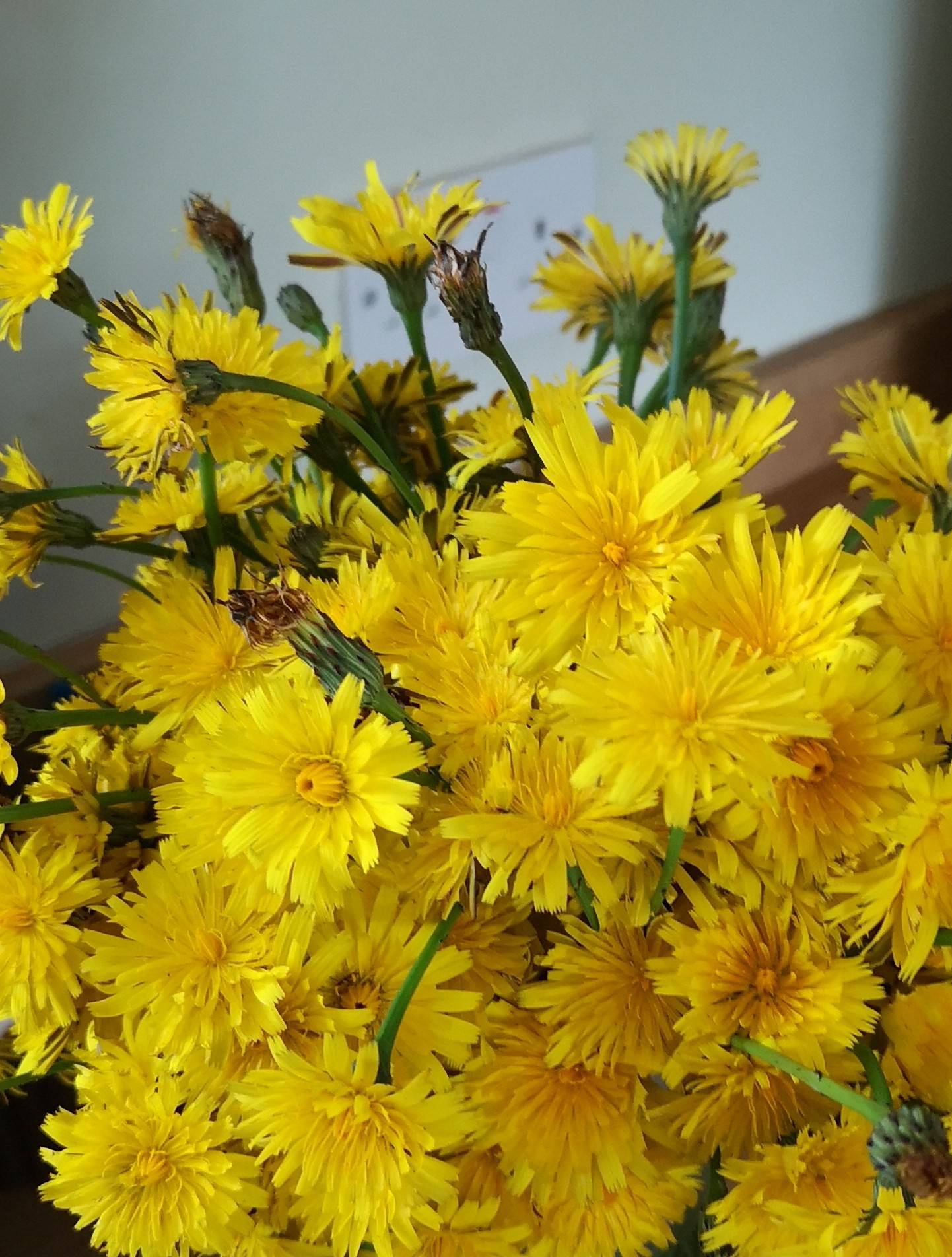
I suspect though that the botanist who first coined the name was operating with the imagination-enhancing benefits of some previously foraged fungi.
As for the wine-making part, I had little knowledge but had recently acquired a dozen demijohns and assorted out-of-date yeasts and finings from a jaded, local home-brew exponent.
How hard could it be? Pretty hard as it transpired – but this was my first time experience, plagued by my natural impetuosity and disdain for preparation and organisation. The lesson I have learned is that this is a methodical and relatively unforgiving craft, especially if the mission is to be as organic as possible and eschew using sulphite stabilisers/sanitizers. I will be delighted if my final product is drinkable, never mind anything of particular quality.
Active fermentation So what was my method and how has it turned out? The answer to the second question is that it’s too early to tell. The wine is in the clearing stage of secondary fermentation. It will require at least another 3 months and possibly 6 to achieve any sort of clarity and refinement. It tastes OK so far; the cat’s ear one is quite strong and still fermenting but the elderflower has settled down and will hopefully need only time to clear (it’s pretty cloudy right now). I also think it’s a touch too dry so some ‘back-sweetening’ may be needed.
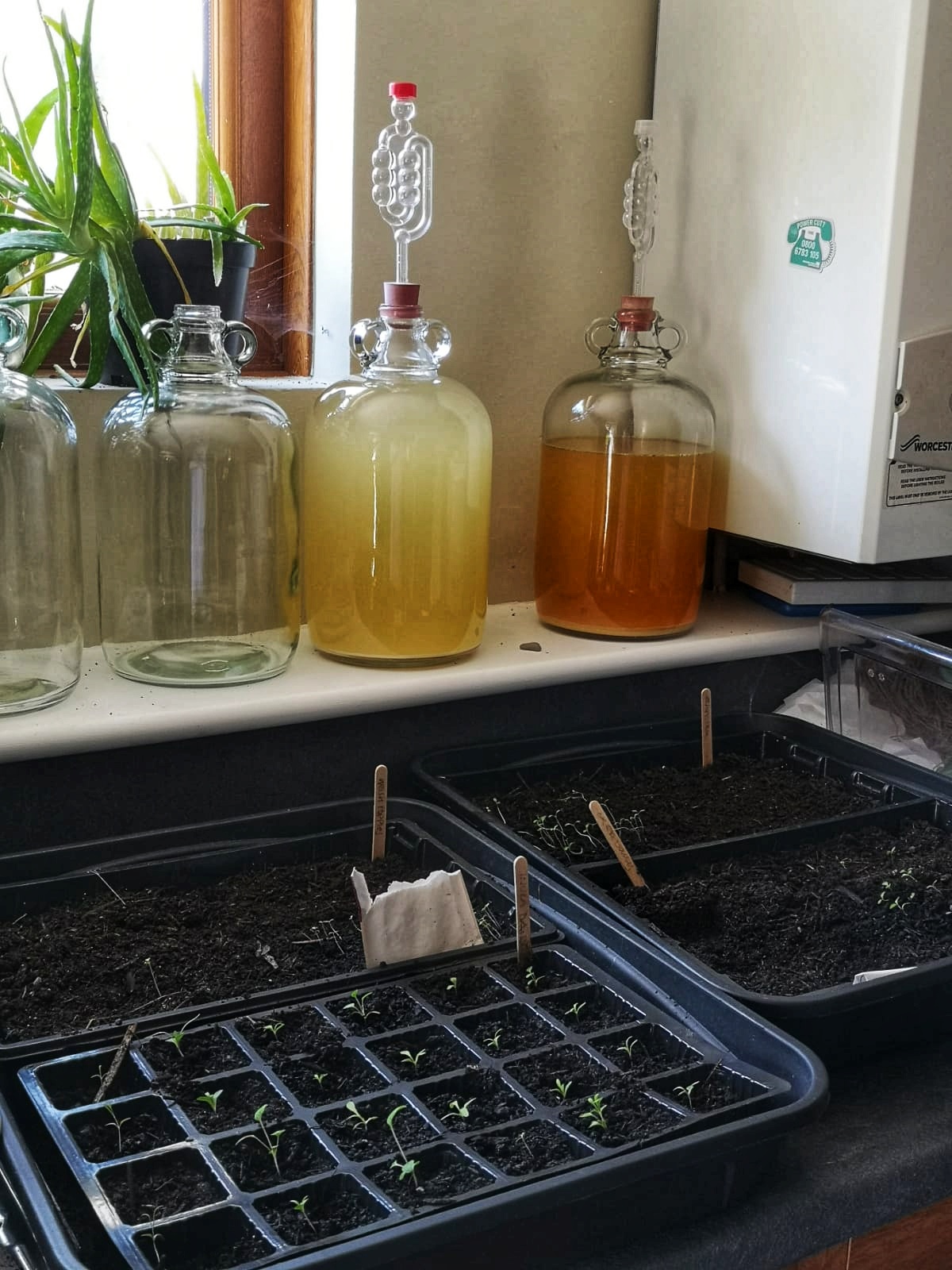
Here are the “recipes” (but I use the term loosely).
Elderflower Wine
The Elder Tree (Sambucus nigra) features heavily in folklore and grows throughout the UK. It can be found in hedgerows, woods, and along roadsides.
Some believe the bark to have magical properties and has been used to create magic wands. Witches allegedly merged themselves into the wood to impart these properties.

The elder flower has delicate creamy white petals with pinpricks of yellow at its centre and emits a sweet, flowery scent. This delicate perfume can be tasted in the champagne or wine, giving it a light, crisp flavour. It’s a good idea to smell the flower heads as you pick them. Once past its best, it can smell like cat pee. Avoid these, as the smell will transfer into the taste of the champagne. I don’t know about you but I try to rule cat pee flavoured wine out of my tasting schedule. Cat’s ear will suffice.

Elderflower Spray 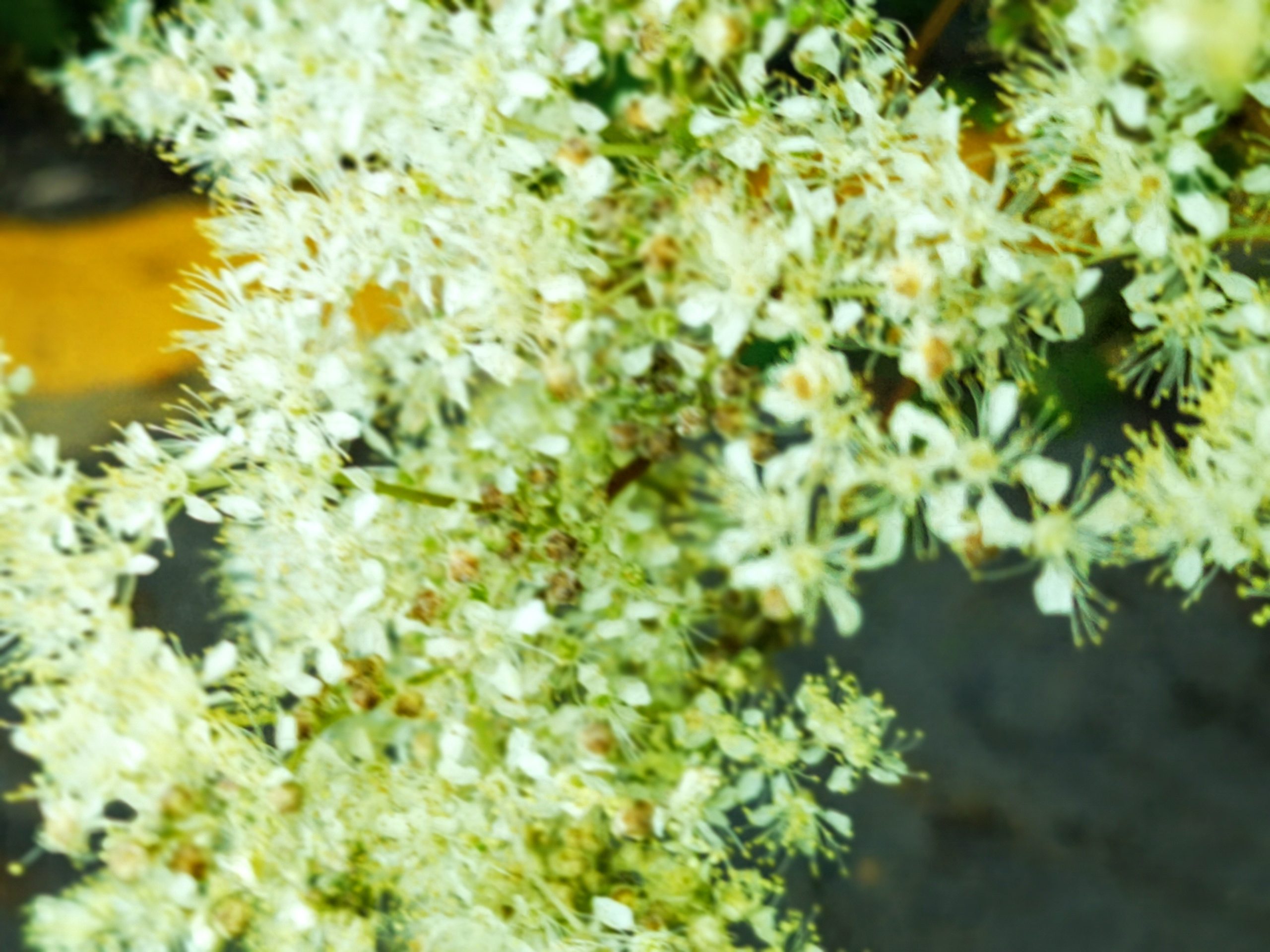
Elderflowers form in ‘sprays’. When foraging, pick the entire head. You’ll also find it’s an excellent idea to forage in the morning before insects descend on the nectar for their lunch! Never take all the flowers from a tree, always make sure you leave enough behind for the rest of nature to enjoy.

Once you get the flowers home, give them a wee shake, then leave them to lie out for a couple of hours. Any insects will normally crawl away at this stage. Don’t worry about the stragglers, you’ll be sieving the flower heads from the first stage liquid and they’ll come along with them. I suppose you could also boast that your elderflower champagne has protein in it, always a bonus!
So, now I’ve helped you identify and find this flower, why don’t you take a peek below for my yummy Elderflower Champagne Recipe and give it a go. And don’t forget, if you don’t want to miss any of my posts, you know what to do…subscribe here!

Elderflower Champagne
Foragers FollyI’ve tried to keep this recipe as simple as possible but don’t let that fool you. The taste of this champagne is pretty amazing.3.82 from 16 votes Print Recipe Pin RecipePREP TIME14 d 1 hrCOOK TIME0 minsTOTAL TIME14 dCOURSEDrinksSERVINGS50
EQUIPMENT
- Bucket, Old Juice Bottles (sterilised), Syphon or Jug, Long Spoon or Stick, Steriliser
INGREDIENTS
- 20 large fresh elderflower heads
- 20 ltrs cold water
- 10 unwaxed Lemons
- 2 kg sugar
- 5 tbsp white wine vinegar
INSTRUCTIONS
- Warm up a ltr of the water and dissolve the sugar in it. Pour it and the rest of the water into a large, plastic or wooden container/bucket.
- Grate or peel the lemon skin and add the zest to the bucket along with the juice of the lemons and the white wine vinegar. Give the contents another good stir.

- Add the elderflower heads (which have their own yeast), making sure you put them in with their heads facing downwards and stems ‘poking’ out of the water. Alternatively, you could take a fork and use it to take the flowers off, leaving the stalks behind. If you can’t find large flower heads, then add another 5 -10 flower heads. Give the contents a gentle stir and cover with a clean tea towel. Leave in a warm, dark cupboard for 2 – 5 days, until fermentation has completed. After 2 days check you’re champagne, which, at this stage, should be showing a mold on the liquid, around the flower heads.
- Once fermentation is complete, gather another bucket, some air tight bottles, a sieve, jug and some muslin cloth. Make sure you sterilise the aforementioned equipment.Scoop out everything floating on top of the liquid in your container. Fold your muslin into four and place it over the sieve. (I use my husband’s old shirts!) and using the jug, sieve the liquid contents into the empty, sterilised bucket/container, leaving about 2 inches of liquid behind. (this allows for any sediment to be left behind) Leave for about an hour, to allow any further sediment to settle.
- Once you’ve completed the above step, it’s time to bottle the champagne. Using your jug, a funnel and muslin cloth, decant the contents of the bucket into the bottles. Remember to leave another couple of inches behind to allow for any sediment. Place your bottles in a dry, warm cupboard for approx 2 weeks, and hey presto…party time. And don’t forget my invite.

